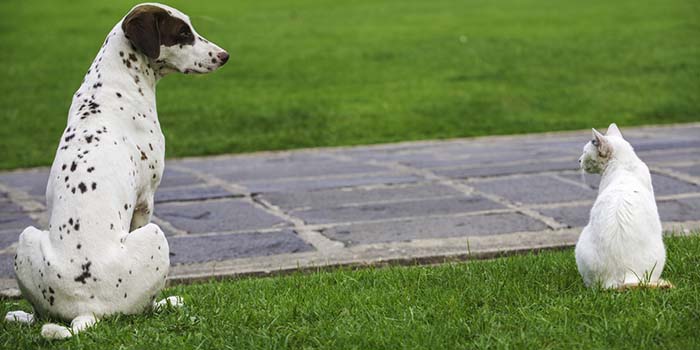It’s no secret that dogs and cats often do not get along. You’ve probably heard the expression “getting along like cats and dogs” for people who can’t stand each other. In most cases, dogs are aggressive towards cats, thus cats are often afraid of and unfriendly towards dogs. However, dogs can be scared of cats too.
If you've recently adopted a new dog or cat, and your pooch is showing fear whenever he is around your feline companion, keeping them together in the same household can be challenging. Let’s take a look at things you can do for a dog scared of cat and to help your pet overcome his fear and make the two get along.
Why Is Your Dog Scared of Cats?
 Dogs that are introduced to cats when they are young will usually get along with cats well. However, when you try to introduce an adult dog to a cat, it's not unusual to see their response to be either aggression or fear.
Dogs that are introduced to cats when they are young will usually get along with cats well. However, when you try to introduce an adult dog to a cat, it's not unusual to see their response to be either aggression or fear.
Dogs that are not properly introduced to cats when they are young can often suffer from a “cat phobia.” If that is not the case and your pooch only seems scared around your cat, the reason may lie in the cat’s behavior.
Cats are often aggressive and territorial, so your dog may be afraid for a good reason. If you ever saw an angry cat, you know how protective and scary they can get. Maybe your cat even attacked your pup and the trauma from this encounter has led to fear.
Whatever the reason may be, there are a few things you can do to help a dog scared of cat overcome this fear.
Introduce Them Carefully
The first impression is often the most important. This is true for animals as well, not just humans. The best thing to do in order to make your dog and your cat get along well is to introduce them properly (here's how to do it).
Of course, depending on your situation, this ship may have already sailed by now. However, you can still try to arrange a proper introduction, even if your dog and cat have already lived together for some time but still don't get along.
1. Use Their Sense of Smell
Separate your dog and cat for a few days to give them both some space. While they are separated, try to get them used to each other’s smell only. You can pet your cat and then let your dog smell her scent from your hand and vice versa. You can bring over your cat's toys to your dog, and do the same with dog's toys.
Once they get used to each other’s smell, you can let them interact in a controlled setting, with you watching over them. It is best to hold your cat in your arms as you introduce her to your dog and slowly get her closer to your pooch. You can also put your cat in a crate or carrier if she doesn’t want to be held, or at least keep your pooch on his leash.
Another thing you can do is use a pet gate. Simply separate the room or hallway using a pet gate, and have your pets on the opposite sides. Allow them to approach each other at their own pace and interact through the gate while you observe them.
2. Wait, Rinse and Repeat
 After you introduce your pets to each other, separate them again. Let them both have their own living area and only get them together for a while each day. The point is to get them accustomed to each other’s company slowly, with you present to prevent altercations. Make sure that they are separated at all times when you are not home.
After you introduce your pets to each other, separate them again. Let them both have their own living area and only get them together for a while each day. The point is to get them accustomed to each other’s company slowly, with you present to prevent altercations. Make sure that they are separated at all times when you are not home.
Over time, gradually increase the length of these sessions until you notice that your pets are completely comfortable with each other. Only then you should let them hang out but still without your supervision only.
If your canine still shows fear during these sessions, don’t try to force him to get over it. Simply leave the room with the dog and try again tomorrow. The older the dog is, the more time he may need, so you need to be patient. Reintroducing your dog to cats until he becomes comfortable is called desensitization. All dogs will stop being scared of cats eventually, but it may take longer with some than with others.
3. Reward Positive Behavior
Teaching and training your dog through positive behavior rewards and discouraging their showing fear is called counter-conditioning. You can train your pooch to stand still or to lie down beside you. Whenever he does something positive, reward him with a treat and praise. Apply the same techniques to dog-cat introductions.
Once your pup knows some of basic dog commands, try to teach him to listen to you when he is in the presence of a cat. Make sure to reward him generously if he behaves well. This will desensitize the dog from being fearful in the presence of a cat as you make the dog focus on a more important task at hand – your commands. Unconsciously, your pup will start getting used to “doing other things” when there's a cat watching.
4. Discourage Negative Behavior
 Your cat may be reacting to your dog’s instinctive negative behavior directed towards her. This can lead to her attacking your dog and he may be frightened because of it. Of course, your cat may act aggressively towards your dog without a reason too.
Your cat may be reacting to your dog’s instinctive negative behavior directed towards her. This can lead to her attacking your dog and he may be frightened because of it. Of course, your cat may act aggressively towards your dog without a reason too.
Try to determine what the case here is and address the negative behavior of your pets, whether it's your cat or your dog. For example, you can spray your cat with water whenever you notice she is unreasonably aggressive towards your dog. Re-train your dog as well if you see the pooch being the instigator. There are other ways you can address your cat’s negative behavior.
5. Eliminate Health Reasons
If your dog is not usually afraid of cats, this change in his behavior can be caused by health reasons, too. For example, the pup may react that way because he has a thyroid disorder. Environmental triggers like lead poisoning can also lead to changes in behavior and dogs are known to behave oddly in those situations.
There are other mental health issues to consider and dog's neurological problems that can come either with age, or directly associated with other illnesses. If you suspect this to be the case, the only thing is to take your dog to the vet to eliminate potential physiological problems and treat any possible health conditions before getting on with training.
6. Hire a Professional
While it is possible for you to help your pooch overcome his fear of cats in some cases, especially if he is still a puppy or a very young dog, often that phobia can be too strong to do anything about it yourself. In these situations, hiring a professional dog trainer or canine behaviorist may be the best course of action.
You may be too emotionally invested in the problem of a dog scared of cat, and getting objective advice and help can be just the thing you need to make the two pets get along.
Conclusion
 Fear in dogs is often a normal and natural response to external or internal stimuli. Your pooch can be afraid of many things and develop phobias for things like loud noises, and fear of cats isn't an exception. Even though this cat phobia in dogs is rare and unusual, you need to address it when it occurs.
Fear in dogs is often a normal and natural response to external or internal stimuli. Your pooch can be afraid of many things and develop phobias for things like loud noises, and fear of cats isn't an exception. Even though this cat phobia in dogs is rare and unusual, you need to address it when it occurs.
The easiest way to deal with this is through desensitization and counter-conditioning which has the best success rate for helping dogs overcome cat phobia specifically. After that, looking into potential health problems may be a good idea. And if nothing else works, seek professional help from a dog trainer or dog behaviorist.
READ NEXT: 13 Dog Breeds That Get Along With Cats














